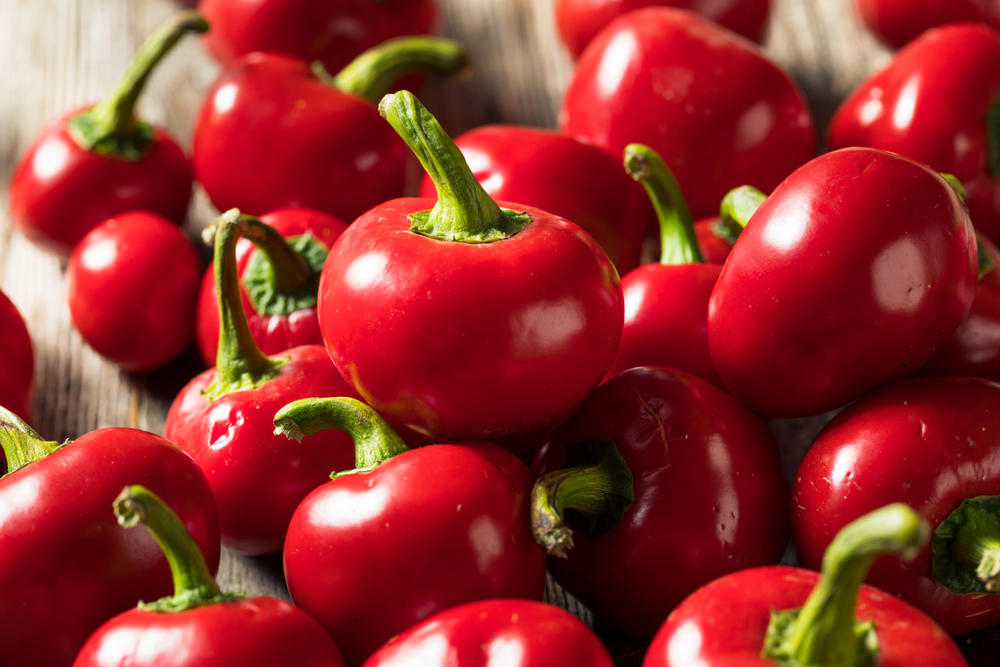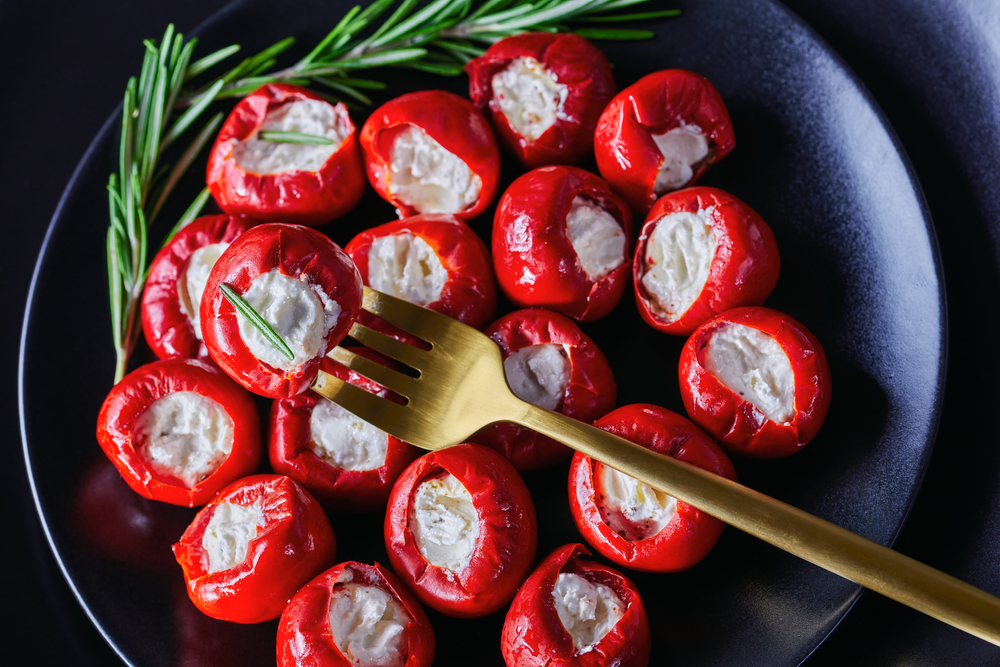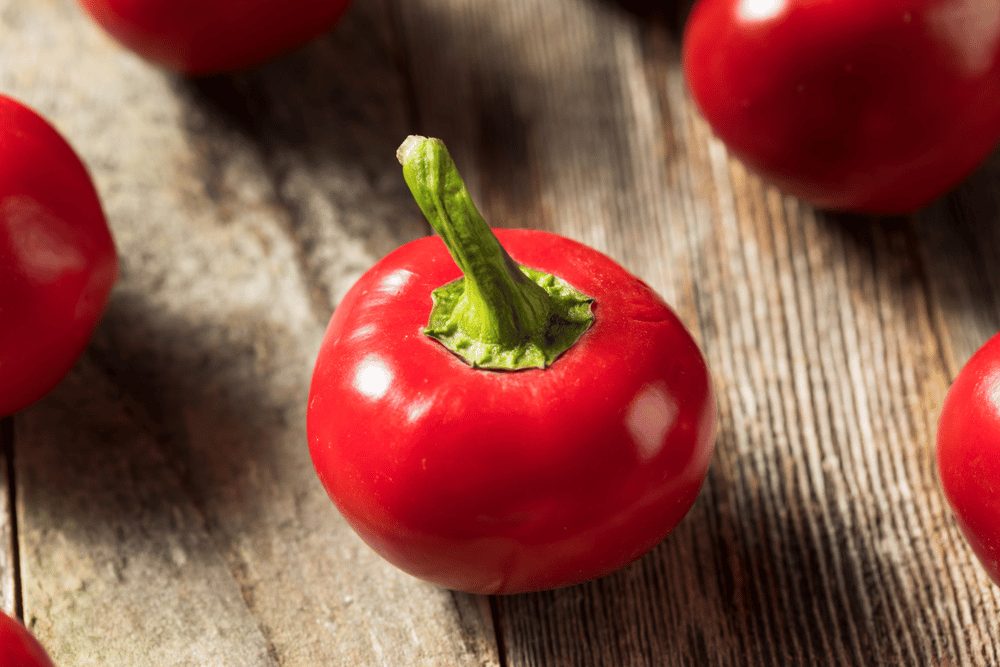Despite their threatening name, cherry bomb peppers are mild hot peppers with delectable notes of sweetness. These petite hybrid peppers were developed in the United States and are famous for their sweetness, early maturity, and disease resistance.
What Is A Cherry Bomb Pepper?
A cherry bomb pepper is a Capsicum annuum hybrid chile developed in the US for disease resistance, sweetness, and fast maturity.
Cherry bomb peppers belong to the Cerasiforme Group in the Capsicum annuum species. The group’s members are commonly referred to as cherry peppers and include:
- Cherry bomb peppers
- Cherry pepper
- Sweet cherry chile pepper
- Red cherry chile pepper
- Hungarian cherry pepper
Because of their cherry-like shape, the members’ names in this group are often used interchangeably, even when they are fundamentally different peppers.
For example, cherry bomb peppers are also called red cherry peppers, cherry hot peppers, hot cherry peppers, red cherry hot peppers, or cherry chile peppers. Despite their mildness, pimento peppers also go by the name red cherry hot peppers.

Color
Cherry bombs start green before ripening to brilliant red at full maturity. You can harvest the peppers when green or leave them to ripen on the vine for more sweetness and spiciness.
Size And Shape
The typical cherry bomb pepper is about two inches long and 1-1.5 inches wide at full maturity. It is a plump, round-to-ovate pepper that resembles a fat cherry, cherry tomatoes, or a globe.
Texture
The skin of cherry bomb peppers is smooth and glossy. It covers the pepper’s juicy flesh, thick walls, and flat cream-colored seeds.
Flavor
Cherry bomb peppers have a sweet flavor and juiciness in the flesh, which waters down the heat of the seeds.
How Hot Is A Cherry Bomb Pepper?
Cherry bomb chili peppers are mildly hot with a Scoville Scale heat level of 2,500-5,000 Scoville Heat Units. This range makes them easily confused with jalapeno peppers taste-wise, which clock 2,500-8,000 SHUs.
A heat score of 2,500-5,000 SHUs isn’t much to warrant the bomb moniker, but it’s rightfully given if you consider that other cherry peppers like pimentos only manage to pack 500-1,000 SHUs.
Compared to other hot peppers like Carolina reapers and apocalypse scorpion peppers at 1,400,000 SHUs, the cherry bombs are far from the super-hot range.
What Is The Difference Between A Cherry Bomb Pepper And A Jalapeno?
Cherry bomb peppers are often confused with jalapenos because of their flavor and heat profile rather than their shape and color.
While cherry bombs have a nearly round shape, jalapenos have a conical shape and are much longer and narrower, tapering to a blunt rounded tip.
The two peppers ripen from green to bright red when fully mature. Because of their red color, you might not tell cherry bomb slices apart from red jalapeno slices.
Jalapenos have a wider Scoville Scale heat range than cherry bomb peppers.
How Do You Cook With A Cherry Bomb Pepper?
Because of their thick, juicy flesh, cherry bomb chiles are excellent in cooked applications like roasting, grilling, baking, and smoking.
The fresh peppers can be stuffed with cream cheese and ground meats to make stuffed peppers for baking. Stuffed cherry peppers are perfect as appetizers, just like jalapeno poppers.
Check out these pepper recipes for prosciutto-stuffed peppers or cherry bomb pepper poppers.

Fresh cherry bombs are also ideal for grilling, smoking, and roasting in their unstuffed form as a side dish for barbecues.
You can slice or dice raw cherry bombs into soups and stews to add a sweet, spicy flavor.
Besides cooking, you can eat cherry bomb peppers raw. However, it’s best to eat the flesh only because it is juicy and not as hot as the seeds, which pack most of the spiciness in the peppers.
Fresh cherry bombs are excellent for pickling. Serve the pickled cherry peppers as a side or add them to a crudite board with cheese, salami, olives, and crusty bread.
Cherry bomb peppers are ideal for making a sweet and tangy cherry bomb barbeque sauce. You can also mix them with other hot peppers like habanero and scotch bonnet peppers to make a spicy cherry bomb hot sauce with more spiciness and nuanced flavor.
Where To Buy Cherry Bomb Peppers
You’ll be lucky to find fresh cherry bomb peppers at your usual supermarket or store. However, you can sometimes find them at local farmers’ markets in the summer.
Pickled cherry bomb peppers are more common, and you can usually find them on grocery store olive bars. These will usually be fresher, and the peppers will still have a bit of a crunch compared to jarred pickled peppers.
Can You Grow Cherry Bomb Peppers
If you can’t find fresh cherry bomb peppers, you can grow your own from seeds purchased online from Amazon and other reputable vendors. Your local gardening center may also carry cherry bomb pepper seeds.
Cherry bombs thrive in full sun in climates that balance warm, humid days with moderately cool nights.
Sow the pepper seeds indoors and plant the seedlings in the spring, about 2-3 weeks after the last spring frost. The planting soil should be warm, moist, and well-drained.
Use a garden spacing of 18-24 inches or plant the pepper plants singly in 18-inch containers filled with soil enhanced with homemade compost.
Substitutes For Cherry Bomb Peppers
Since cherry bomb peppers have a sweet flavor and little to no heat, you can substitute them in fresh or cooked applications with sweet pepper varieties like bell peppers, Santa Fe Grande peppers, gypsy peppers, and carmen peppers.

